Milton Friedman was touring India, and while there he shocked his audience by stating, “Inflation is always and everywhere a monetary phenomenon.” This was 1963, and the audacity of that statement is today understated. Back then, Keynes didn’t just rule there was hardly any opposition to such accepted orthodox dogma.
Arguing from firmly empirical rather than theoretical grounds, Friedman’s effort was only in getting people to acknowledge the very straightforward implications of these mountains of evidence. For as much of a challenge initially, objections would diminish over the next few years and decade. The Great Inflation became impossible to just ignore from a purely Keynesian perspective.
With excess money, there will be inflation. Without the money, there won’t be. Find the money, find the inflation. What could be easier?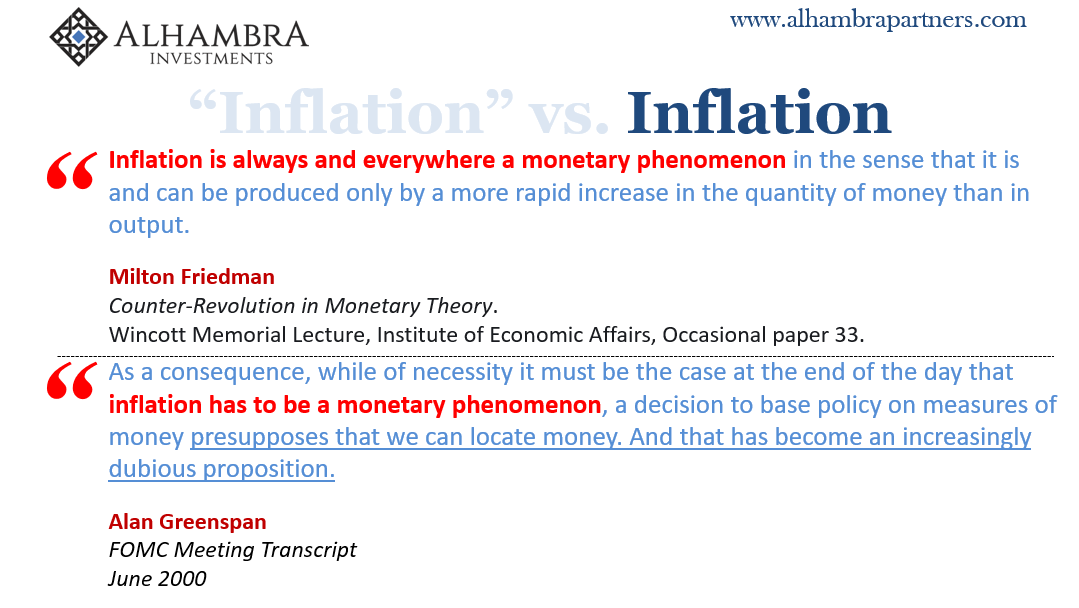
You may have heard recently, most of this year, in fact, that inflation is running rampant.
It isn’t. How do we know? Lack of money, same as before.
Wait, hold up. Some say you need only take a look at M2, that it points out all the money for the CPI’s. After all, this is – by its definition – a monetary aggregate. It might have taken a little longer to flow into the real economy, but there’s absolutely no arguing the excessiveness of M2 since March 2020 and an apparent if delayed correlation to consumer prices.
Therefore, if we’ve found the money in M2 it won’t be just recent CPI’s but many more to come like it. 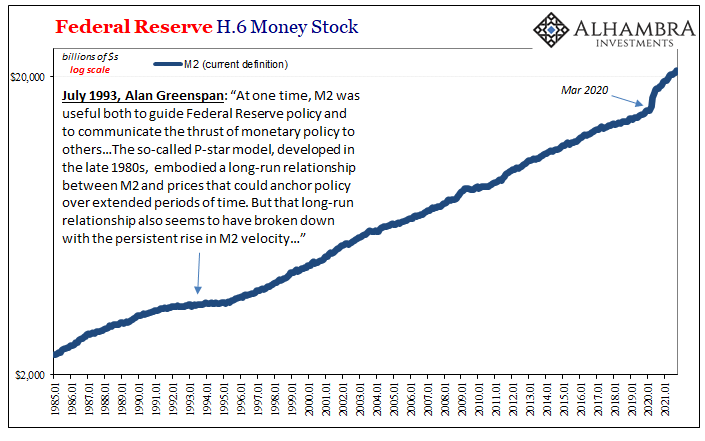

No. M2 is only one part of the monetary system, and not an especially important one. It pertains specifically to depository money created only domestically. No wholesale; no offshore.
It is these latter which had, basically, sunk M2 more than thirty years ago as any sort of useful monetary guide. And its demise was basically an exact repeat of what happened to M1 just a few decades before, making it pretty easy, too, to chart real world monetary progression.
In the early seventies, the Great Inflation raging, some economists and central bankers began to realize how M1 was misleading (so much so, it justified for President Nixon to undertake doomed and really absurd wage/price control measures). In terms of basic math, M1 growth kept coming up well short of forecast demand and M1 velocity seemed to rise.
The reason was the real economy years before had turned more and more to different forms of money that weren’t included. It doesn’t matter how the government or the Federal Reserve classifies monetary definitions, central bankers don’t decide on what’s money or not, it only matters how real economy participants use whatever might be available; wholesale formats including some like repurchase agreements.
Just as some at the St. Louis Fed realized in 1979:
To the extent that RPs [repurchase agreements, or repo] are used to accumulate liquid balances over a period for some anticipated future outlay, they may be more appropriately classified as time deposits rather than demand deposits; such balances would be more appropriately included in the M2 concept of money which includes liquid savings, rather than the M1 concept which does not. Even if it is concluded that RPs are not money (M1), however, the rapid growth of this highly-liquid asset has almost certainly affected the velocity of demand deposits by permitting corporations to obtain desired liquidity with fewer demand deposits than otherwise.
Outdated M1 was eventually, reluctantly downgraded outwardly in favor of a broader M2 which only made it seem like central bankers were trying to keep pace with this tricky monetary progression(s).
In reality, the Fed by 1982 had already come to realize even this was largely a waste of their time since even a broader definition wouldn’t be able to manage. Officials might refer to M2 occasionally, never really placing much emphasis on it while they turned exclusively to “expectations” management.
In the late eighties and early nineties, M2 did eventually run aground of the same issues which had grounded M1. Velocity spiraled upward, indicating something again very wrong with the data. Alan Greenspan in 1993 went so far as to explicitly state in front of Congress the Fed had given up on the statistic in favor of exclusively interest rate targeting (they would anchor to economic not money aggregates) he told politicians and the public would be a reliable workaround in lieu of any concrete monetary measure or even useful set of definitions.
As I wrote in a bit more detail last Friday:
Interesting, then, how the same problem over a decade later would befall M2! Velocity suddenly rose around 1990 for reasons no one could adequately explain (assuming anyone at the FOMC really wanted to). Policymakers had come to believe they wouldn’t need to – that’s the whole thing behind “discretionary” policy. It was taking the central bank into a realm that wasn’t central banking, at least nothing like what was described traditionally.
The timing of all this wasn’t coincidence, just like it hadn’t been for M1’s demise in the early seventies. But if simpler “wholesale” developments like repo had been “taking” demand away from the M1 components that long ago, it would be far more complex things (“networks of interbank relations”) and more of them offshore which would be responsible for eliminating M2’s practicality.
Evidence for them was all over the place. To begin with, the downfall of the depository: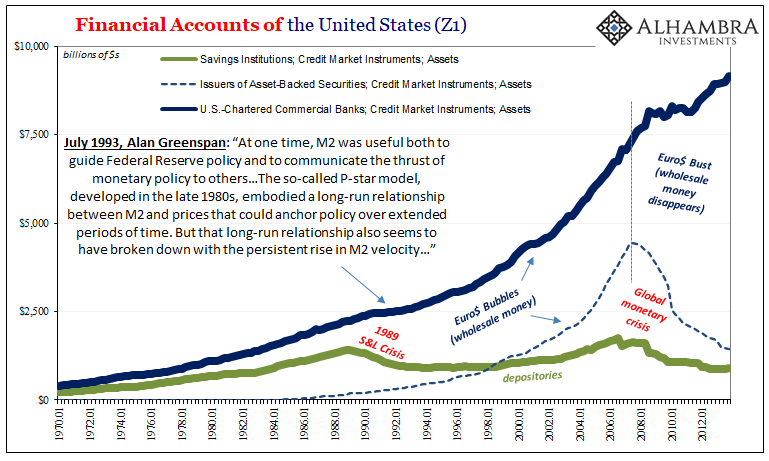
Commercial banking was an entirely different subset of “banking”, those firms more like securities dealers (and really hedge funds) than anything of an actual bank. With the S&L Crisis reaching its climax late in ’88 – right around when M2 velocity started to go screwy – the “commercial bank” relying more and mostly on wholesale forms of money, including repo, became truly ascendant.
Not just ascending, but essentially replacing depositories and depository money at the margins of growth and for newfound uses all over the world.
This came in other forms, too, like the parallel rise in wholesale off-balance sheet entities, those like ABS Issuers (shown above) which by themselves massively outgrew the traditional bank during the nineties.
Even the Z1 banking data (above) is itself incomplete, not capturing what was even more opaque, ill-defined, as well as even more quickly escalating. I wrote last year:
These enormous figures had ballooned up from Morgan Guaranty’s guess of around $50 billion gross back when nearer the eurodollar’s start in the early sixties. Missing money, indeed. Less than a decade later, each of the M’s had been surpassed by what nobody talked about…The gross eurodollar size was in 1988 a third greater than the entire M2 stock would be three years afterward, while its net size was closing in on two-thirds of it. And this was three decades ago.
Here’s the thing; at least Morgan Guaranty unlike the Fed had made an honest effort for years (going back to the sixties) to try and size up the offshore wholesale component to real world money. Right around the time M2 was coming undone, Morgan Guaranty stopped compiling their eurodollar estimates because the company realized – thirty-three years ago – there was too much going on, so much more yet to be uncovered and thus impossible to document.
All of it outside M2 (and M3).
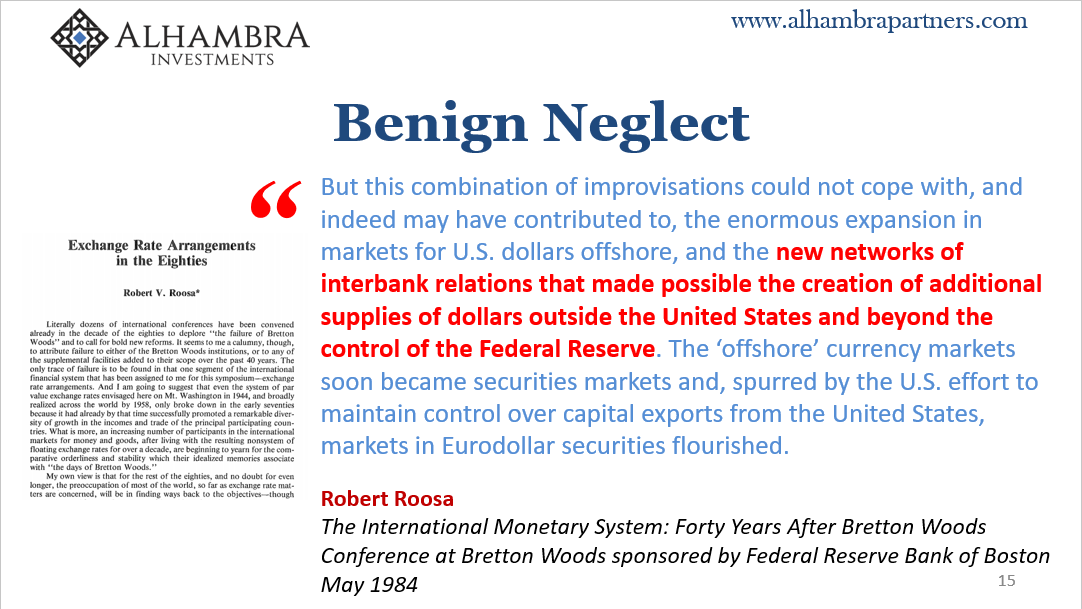
The entire global economy was using money that might not have looked like money to simple Economics, and far, far more of it outside of M2 than inside. The so-called broad aggregates therefore could only give you a partial monetary picture which was, as I wrote already, a not very important or useful one. They weren’t even close to broad enough.
These wholesale and shadow money forms, onshore as well as offshore, were the products of commercial not central banks.
Perhaps the best illustration of just how misleading M2 had become was in how during the worst monetary crisis since the Great Depression, M2 rose substantially. Yep, in the months leading up to Bear Stearns – a period no one should equate with overflowing money – and then even more in the weeks and months which followed Lehman/AIG/et al.
The worst parts of the worst monetary panic (that was global in reach, for another clue) since the early thirties and M2 was suggesting an overflow of money, maybe even an inflationary one – right as the entire monetary and therefore real world was experiencing outright deflation for the first time since around the middle fifties. 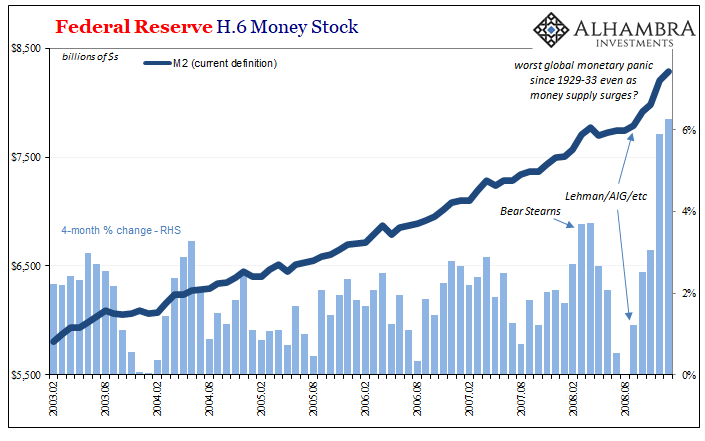
Quite simply and obviously, M2 is beyond antiquated to the point of being unhelpful.
What are we to do in lieu of any legitimate monetary aggregate? The Fed just gave up on M3 back in early 2006, and despite that whole huge monetary crisis (“somehow” blamed on subprime mortgages), no one’s bothered to take up the task in all the years (and QE failures) since.
Even so, there is a time-tested and reliable monetary indicator widely available nonetheless. You need only listen instead to the commercial banks, those in the shadows producing, or not, these very money forms.
The signals they send out into the public, in real time, are surprisingly easy and straightforward to interpret, requiring no math of any kind nor convoluted theories to explain what should be easy numbers.
Yields. Not only are they produced by these same commercial banks, they are derived from the monetary utility priced into what is essential repo collateral.
Friedman’s “law” remains. While easy to say inflation is a monetary phenomenon, figuring out what that phenomenon is in the modern wholesale, offshore practice takes a step (or several) beyond current Economics (and way beyond M2). Empirically still the same, analytically very different, and, when it comes to inflation post-2007, the money’s still missing.
Best of all, you don’t have to take my word for it. Though I call it shadow money, that’s only because central bankers, Economists, and mainstream monetary aggregates are in the dark. There’s no monetary law requiring you to sit in confusion with them. 
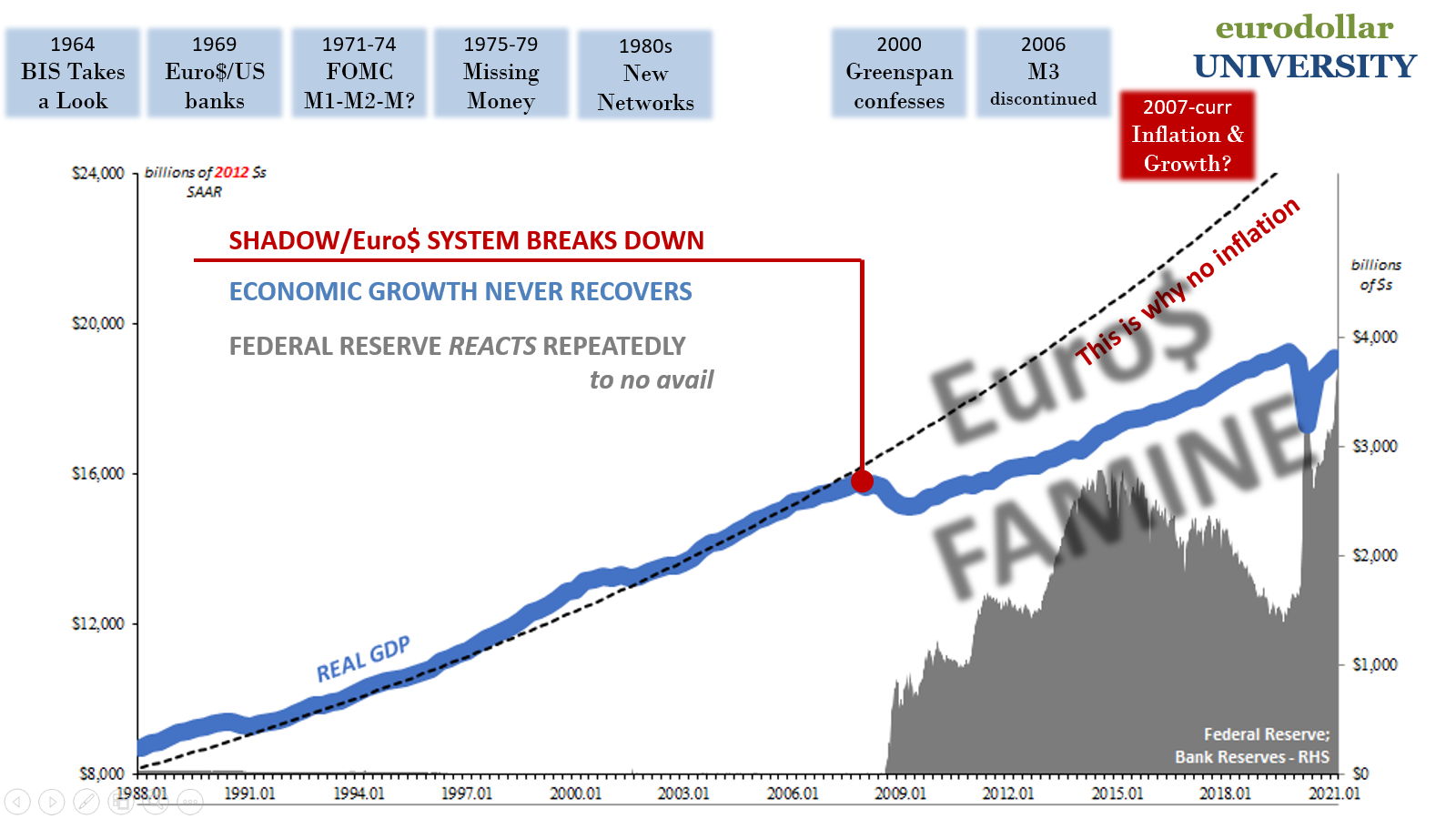

Stay In Touch